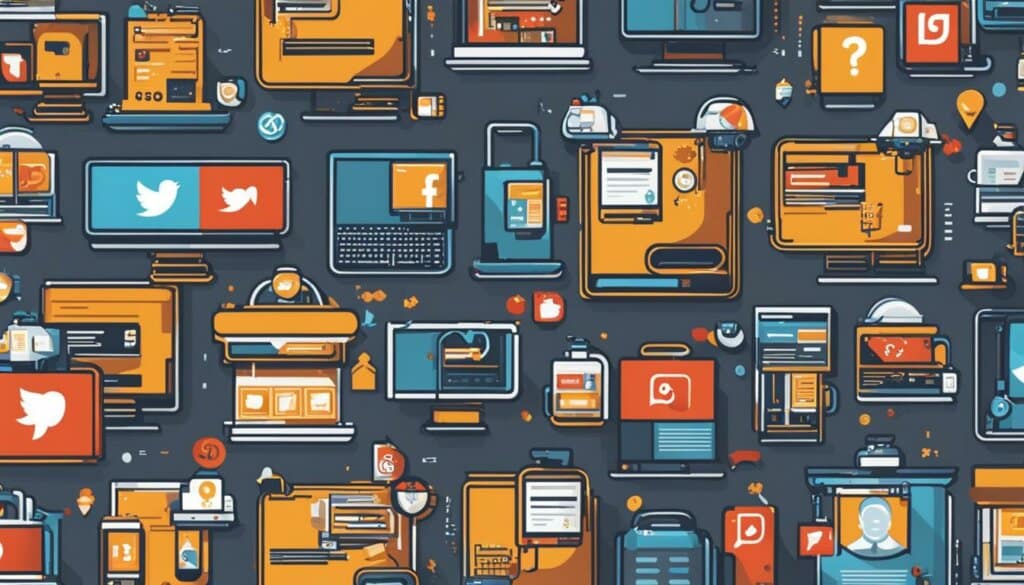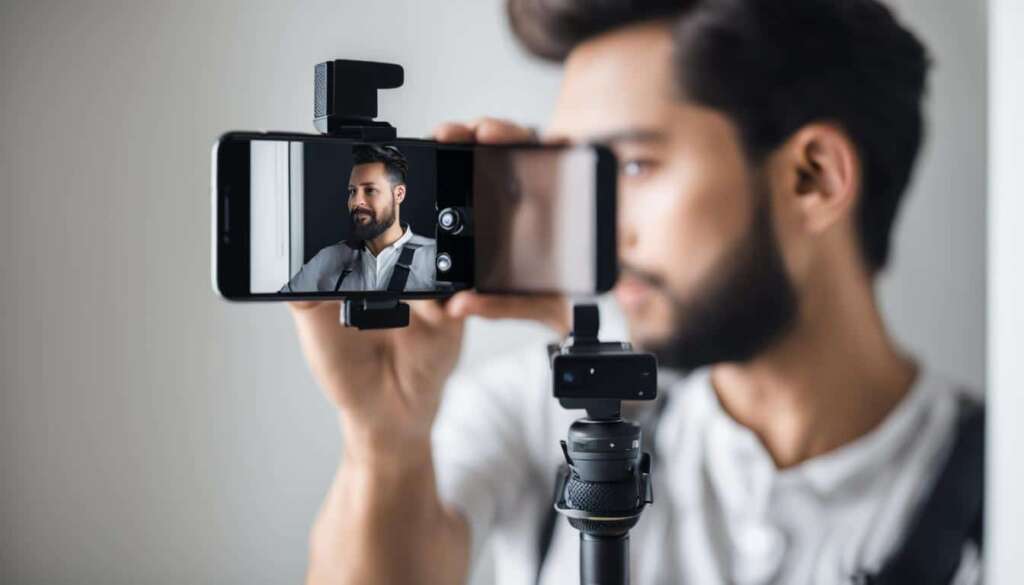Table of Contents
Social media bots have become increasingly prominent in the world of digital marketing. These automated programs mimic human interactions on social media platforms, performing tasks such as liking posts, sharing content, and creating comments. As marketers strive to maximize the effectiveness of their campaigns, understanding the role of social media bots and automated tools is crucial.
With the rise of social media bots, the landscape of social media marketing has significantly evolved. Bots can be beneficial in enhancing customer engagement, increasing efficiency, and saving time and resources. Chatbots, for example, can provide round-the-clock customer service and guide users through basic sales processes.
However, it’s important to recognize the potential downsides and limitations of relying too heavily on social media bots. Bots can skew analytics, giving a misleading picture of campaign success. They can dilute genuine human interaction, making it difficult for marketers to gauge the true level of interest and reception of their content. Moreover, if a brand’s content is predominantly engaged with by bots, it can harm the brand’s credibility and reputation.
Despite these challenges, social media bots and automated tools can still be valuable assets in marketing strategies when used strategically and ethically. Marketers need to navigate the bot storm by implementing bot detection tools, closely monitoring engagement, and allocating resources effectively.
By understanding the benefits, limitations, and potential risks associated with social media bots, marketers can ensure that their campaigns remain effective and reflect genuine engagement with their target audience.
The Skewing of Analytics
Social media bots have the ability to distort the analytics of marketing campaigns by inflating engagement metrics. These bots engage in activities such as leaving comments, likes, and shares that have no real value. As a result, marketers may struggle to accurately assess the true level of engagement and reception of their content.
The presence of social media bots can create a misleading picture of campaign success. While the number of likes and shares may appear impressive, the true level of genuine human engagement may be significantly lower. Marketers need to be aware of this skewing effect and take it into consideration when evaluating the effectiveness of their campaigns.
“The impact of social media bots on analytics can be significant. It’s important for marketers to dig deeper into engagement metrics and consider the quality and authenticity of interactions.”
By relying solely on inflated engagement metrics, marketers run the risk of making misinformed decisions about their strategies and allocating resources inefficiently. Accurate analytics are crucial for understanding the true impact of marketing campaigns and making informed decisions for future campaigns.
| Implications of Skewed Analytics | Actions for Marketers |
|---|---|
| Difficulty in accurately assessing campaign success | Utilize bot detection tools to filter out bot-generated activity |
| Misallocation of resources | Closely monitor engagement metrics to identify genuine human interactions |
| Misguided decision-making | Consider the quality and authenticity of engagements rather than relying solely on quantity |
Table: Implications of Skewed Analytics and Actions for Marketers
The Diluted Impact of Social Media Bots on Genuine Human Engagement
As social media bots continue to proliferate, marketers are faced with the challenge of distinguishing genuine human interaction from bot-generated activity. This diluted engagement presents a significant obstacle to accurately gauging the true level of interest and reception of marketing content. With bots actively engaging in likes, shares, and comments, marketers must find effective strategies to ensure that their campaigns are resonating with real users.
One way to address this issue is through close monitoring of engagement metrics. By analyzing the quality and nature of interactions, marketers can gain valuable insights into the level of genuine human engagement. This can involve examining factors such as the duration of time spent on a post, the depth of comments, and the sentiment expressed in interactions. By focusing on these qualitative aspects, marketers can gain a clearer understanding of the impact their campaigns are making on real users.
Furthermore, implementing bot detection tools can help identify and filter out bot-generated activity. These tools employ sophisticated algorithms to detect suspicious patterns and behaviors, allowing marketers to differentiate between genuine human interactions and automated bot activity. By utilizing these tools, marketers can ensure that their metrics accurately reflect the level of interest from real users, allowing for more informed decision-making and campaign optimization.
Table: Comparing Genuine Human Engagement vs. Bot-generated Activity
| Genuine Human Engagement | Bot-generated Activity | |
|---|---|---|
| Depth of Comments | Affected by emotions, personal experiences, and opinions | Generic, repetitive, and often unrelated to the content |
| Time Spent on a Post | Significant time invested in reading, comprehending, and engaging with the content | Quick, automated interactions without meaningful time investment |
| Sentiment Expressed | Varied emotions and nuanced opinions, reflecting genuine experiences | Impersonal and generic, often lacking emotional depth |
“Understanding the diluted impact of social media bots on genuine human engagement is crucial for marketers seeking to accurately measure the success of their campaigns.”
By acknowledging and addressing the challenges posed by diluted engagement, marketers can make more informed decisions about their strategies and optimize their campaigns for genuine human interaction. Taking advantage of advanced bot detection tools and closely examining qualitative engagement metrics are key steps in ensuring that marketing efforts are resonating with real users.
Reputation Damage
The use of social media bots can have a detrimental effect on a brand’s reputation and credibility. When a brand’s content is predominantly engaged with by bots, it can create an impression that the brand is not reputable or trustworthy. This association with spammy or malicious bots can damage the brand’s image and discourage genuine users from engaging with the content or considering the brand’s products or services.
Reputation damage caused by social media bots can result in negative public perception, which can be challenging to overcome. Bots are often associated with fake followers, comments, and likes, which raises questions about the authenticity and reliability of a brand or its content. This can erode the trust that consumers have in the brand, making it difficult to build long-lasting relationships and loyalty.
It is essential for marketers to be aware of the potential reputation risks associated with social media bots and take proactive measures to mitigate them. By focusing on creating quality content and encouraging genuine user engagement, brands can build a positive reputation and restore consumer trust. Additionally, implementing effective bot detection and filtering mechanisms can help identify and eliminate bot-generated activity, further safeguarding the brand’s reputation.
| Impact | Description |
|---|---|
| Brand Credibility | Being associated with spammy or malicious bots can harm a brand’s credibility and make it seem less reputable. |
| Consumer Trust | Bots create a perception of inauthenticity, leading to a lack of trust from consumers. |
| Negative Public Perception | Reputation damage caused by bots can result in negative public perception, affecting the brand’s image. |
Increased Costs
Social media bots can significantly impact marketing budgets, leading to increased costs and potential budget drains. When marketers pay for engagements that have no real value, it can quickly deplete their allocated budgets. It is important to allocate resources efficiently and effectively to minimize the financial impact of bot interactions.
One of the main reasons for increased costs is that bots are not potential customers. They are simply programs designed to mimic human behavior and engagement. By paying for interactions that do not contribute to genuine engagement or conversion, marketers are essentially wasting their resources.
To mitigate the financial impact of bots, marketers need to be proactive in detecting and filtering out bot activity. Investing in bot detection tools can help identify and block bot interactions, ensuring that allocated budgets are focused on genuine human engagement. Close monitoring of engagement metrics is also crucial to discern genuine human interactions from bot-generated activity.
| Implications of Increased Costs | Strategies to Mitigate Costs |
|---|---|
| Budget drain | Invest in bot detection tools |
| Inefficient allocation of resources | Monitor engagement metrics closely |
| Wasted advertising spend | Filter out bot activity |
By adopting these strategies, marketers can ensure that their budgets are not drained by interactions that do not contribute to their marketing goals. Allocating resources more efficiently and effectively will allow them to maximize the impact of their campaigns and make better use of their marketing budgets.
Social media bots have become a pervasive presence on various platforms, impacting digital marketing campaigns in significant ways. To effectively navigate the bot storm, marketers need to be proactive in implementing bot mitigation strategies that can minimize the negative effects and optimize campaign performance.
One crucial strategy is the use of bot detection tools. These tools employ advanced algorithms to identify and filter out bot activity, allowing marketers to focus on genuine human interactions. By utilizing such tools, marketers can gain a clearer understanding of their true audience and make data-driven decisions to optimize their campaigns.
Closely monitoring engagement on social media platforms is also essential. Marketers should keep a close eye on metrics such as likes, comments, and shares, looking for patterns that may indicate the presence of bots. By distinguishing between bot-generated activity and genuine human interaction, marketers can accurately assess the effectiveness of their content and make necessary adjustments to improve engagement.
Additionally, allocating resources efficiently can help reduce the financial impact of bot interactions. By analyzing data on bot activity and engagement, marketers can identify areas where resources are being wasted and reallocate them to more productive channels. This strategic approach can help maximize the return on investment and minimize the budget drain caused by bot interactions.

| Bot Mitigation Strategies | Benefits |
|---|---|
| Utilize bot detection tools | – Identify and filter out bot activity – Gain insights into genuine human interactions – Optimize campaign performance |
| Closely monitor engagement | – Distinguish between bot-generated and human interactions – Accurately assess content effectiveness – Make necessary adjustments to improve engagement |
| Allocate resources efficiently | – Analyze data on bot activity and engagement – Identify wasted resources – Reallocate resources to more productive channels |
Different Types of Bots
When it comes to social media bots, it’s important to understand that not all bots are created equal. There are various types of bots that serve different purposes in the realm of social media marketing. By differentiating between these types, marketers can better utilize the potential benefits of bots while mitigating the risks.
One common type of bot is the chatbot. Chatbots are designed to mimic human interaction and provide customer service on social media platforms. They can assist users with inquiries, provide information about products or services, and guide them through basic sales processes. Chatbots offer a level of convenience and accessibility, allowing businesses to engage with their customers 24/7.
Another type of bot is the content dissemination bot. These bots are programmed to automatically share and promote content on social media platforms. They can help increase the visibility of a brand’s content and reach a wider audience. However, it’s important for marketers to ensure that these bots are promoting valuable and relevant content to maintain authenticity and engagement.
Table: Types of Social Media Bots
| Bot Type | Purpose |
|---|---|
| Chatbot | Virtual customer service representative, assists with inquiries and provides information |
| Content Dissemination Bot | Automatically shares and promotes content on social media platforms |
By understanding the different types of bots, marketers can make informed decisions about which ones align with their marketing goals. Whether it’s utilizing chatbots for customer service or content dissemination bots to increase reach, incorporating bots strategically can enhance a brand’s social media marketing efforts.
The Benefits of Bots in Marketing
Social media bots play a significant role in enhancing customer engagement and streamlining marketing efforts. When used strategically, these automated tools can bring numerous benefits to businesses, helping them achieve their marketing goals more efficiently. Let’s explore some of the advantages of incorporating bots into marketing strategies.
Improved Customer Engagement:
One of the primary benefits of social media bots is their ability to enhance customer engagement. Chatbots, for example, can provide immediate and personalized responses to customer queries, improving customer satisfaction and retention. By offering round-the-clock support, chatbots ensure that customers receive prompt assistance whenever they need it, resulting in a positive brand experience. Additionally, these bots can guide users through basic sales processes, helping to generate leads and increase conversions.
Time and Resource Efficiency:
Deploying social media bots can save businesses valuable time and resources. With bots handling routine and repetitive tasks, such as content dissemination or gathering customer information, marketing teams can focus on more strategic initiatives. This increased efficiency allows marketers to allocate their resources more effectively, maximizing their productivity and ultimately improving overall campaign performance.
“Social media bots can enhance customer engagement, increase efficiency, and save time and resources.”
Lead Generation and Awareness:
Bots can also play a crucial role in lead generation and raising brand awareness. By leveraging bots to disseminate targeted content and engage with potential customers, businesses can expand their reach and attract new prospects. Bots can initiate conversations, share valuable information, and guide users towards specific products or services, ultimately driving conversions and growth.
To summarize, social media bots offer numerous benefits to marketers, including enhanced customer engagement, improved efficiency, and increased lead generation. By integrating these automated tools into their marketing strategies, businesses can effectively reach and engage with their target audience, leading to greater success in their digital campaigns.

The Limitations of Bots in Marketing
Social media bots have become an integral part of digital marketing strategies, offering numerous benefits such as enhanced customer engagement and increased efficiency. However, it is important to acknowledge the limitations of bots in marketing to ensure that their implementation aligns with the overall goals and objectives of a campaign.
One of the main limitations of bots in marketing is their impersonal nature. Unlike human interactions, bots lack the ability to establish personal connections or understand the nuances of individual preferences. This can result in a less personalized and tailored experience for customers, potentially leaving them feeling unsatisfied or frustrated. While bots can handle basic inquiries and provide general information, they may struggle to deliver the level of customer service that human representatives can offer.
Another limitation is the difficulty in capturing the true essence of human interaction. Bots are designed to mimic human behavior, but they can never fully replicate the genuine emotions, empathy, and understanding that humans bring to the table. This can impact the overall effectiveness of marketing campaigns, as customers may not feel truly understood or valued. It is important to strike a balance between bot automation and human interaction to create meaningful connections with customers.
| Limitations of Bots in Marketing | Impact |
|---|---|
| Impersonal interaction | Limited ability to establish personal connections with customers |
| Lack of genuine human interaction | Difficulty in capturing and replicating the nuanced emotions and understanding that humans bring |
In conclusion, while social media bots offer valuable benefits in marketing campaigns, they also have their limitations. Recognizing these limitations and finding ways to mitigate them is crucial for marketers to ensure that their strategies effectively engage with their target audience and provide a positive customer experience.
The Dark Side of Bots
Social media bots, while having some potential benefits in marketing, also have a dark side that can pose significant risks to brands and their reputations. The misuse of bots for malicious purposes can lead to reputation damage and negative public perception. It is essential for marketers to understand these risks and take proactive measures to mitigate them.
One of the major concerns with social media bots is their ability to create fake followers and comments, spread fake news, and manipulate public opinion. Bots can be programmed to generate a large number of fake accounts, which can artificially inflate a brand’s follower count. This not only gives a false sense of popularity but also undermines the credibility and authenticity of the brand.
“The misuse of social media bots can create a perception that a brand is engaging in unethical practices and undermine its reputation.”
Fake news is another significant issue associated with bots. Bots can be programmed to spread misinformation, creating confusion and influencing public opinion. This can have serious consequences, especially in areas such as politics, where the spread of false information can impact elections and public trust in institutions.
Additionally, the association with spammy or malicious bots can harm a brand’s reputation and credibility. If a brand’s content is predominantly engaged with by bots, genuine users may view it as untrustworthy and choose not to engage with it. This can lead to a decline in customer trust and loyalty, ultimately impacting the brand’s success.
Given these risks, it is crucial for marketers to be aware of the potential dark side of social media bots and to implement robust measures to detect and mitigate bot activity. By monitoring engagement closely, using bot detection tools, and prioritizing genuine human interaction, marketers can protect their brand’s reputation and maintain trust with their audience.
Conclusion
Social media bots have become a significant factor in the world of digital marketing. While they offer benefits such as enhanced customer engagement and increased efficiency, their limitations and potential risks must be carefully considered.
One of the key challenges posed by social media bots is their ability to skew analytics, making it difficult for marketers to accurately measure the success of their campaigns. Bots can inflate engagement metrics, creating a misleading picture of audience interaction and reception.
Furthermore, the presence of bots on social media platforms can dilute genuine human engagement, making it harder for marketers to gauge the true level of interest in their content. This can impact the effectiveness of marketing campaigns and hinder the development of authentic connections with the target audience.
It is essential for marketers to navigate the bot storm by employing effective bot detection tools and closely monitoring engagement. By doing so, they can filter out bot activity, allocate resources more efficiently, and ensure that their campaigns reflect genuine engagement with their target audience.
FAQ
What are social media bots?
Social media bots are automated programs that mimic human interactions on social media platforms. They can like, share, comment, and create posts.
How do social media bots impact analytics?
Social media bots can inflate engagement metrics, leading to a misleading picture of campaign success. They leave comments, likes, and shares that have no real value, distorting the true level of engagement with content.
How do social media bots affect human engagement?
With bots actively engaging in content, it becomes challenging to distinguish genuine human interaction from bot-generated activity. This can make it difficult for marketers to gauge the true level of interest and reception of their content.
Can social media bots harm a brand’s credibility?
Yes, if a brand’s content is predominantly engaged with by bots, it can harm the brand’s credibility and reputation. Association with spammy or malicious bots can create a perception that the brand is not reputable.
Do social media bots increase marketing costs?
Yes, bots can contribute to increased costs in digital marketing campaigns. Paying for engagements that have no real value can quickly drain a marketing budget.
How can marketers mitigate the impact of social media bots?
Marketers need to be vigilant and proactive in mitigating the impact of social bots. Using tools that can identify and filter out bot activity is essential. Close monitoring of engagement to discern genuine human interactions is crucial.
What are the different types of social media bots?
There are various types of social media bots. Some bots, like chatbots, serve as virtual customer service representatives or marketing professionals, assisting with inquiries and providing information. Others bots are designed to disseminate content or promote specific causes on social media platforms.
What are the benefits of using bots in marketing?
Bots can enhance customer engagement, increase efficiency, and save time and resources. They can provide 24/7 customer service, raise awareness for causes, and generate leads.
What are the limitations of using bots in marketing?
The biggest limitation of bots in marketing is their impersonal nature. Bots cannot establish personal connections or understand the nuances of human interactions. They are limited in their ability to provide customized experiences.
Are there any risks associated with using bots in marketing?
Yes, bots can be used for malicious purposes, such as creating fake followers and comments, spreading fake news, and influencing public opinion. The misuse of bots can lead to reputation damage and negative public perception.













